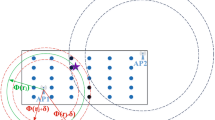Abstract
Device-free indoor localization (DFIL) system can locate the position of human body in the indoor environment by observing the changes in the received signal strength indicator (RSSI) of the wireless local area network (WLAN). The accuracy of a DFIL system is depreciated, as the change in the indoor environment due to furniture and other infrastructure movement. This paper investigates the development of testbed of the WLAN network for measuring the RSSI in various indoor environment, as the initial step for designing the fingerprinting-based algorithms for WLAN network. The database of RSSI fingerprint is created initially and then a fingerprint-based algorithm is developed for locating the position of a human body in the indoor environment. The localization algorithm tests the minimum distance in the RSSI values related to the different test points in the indoor environment. This work further demonstrates that how the fingerprints of RSSI are collected and which network configurations generate the most reliable RSSI measurement. For the first phase of designing the testbed, the configurations of different equipment and various tools are elaborated in the indoor environment. For the second phase the RSSI is measured in different propagation indoor environment. The extensive experiments were performed that allow quantification of how changes in an environment affect accuracy. Thus, it is demonstrated that each link offers a viable approach to developing a more robust system for device-free localization that is less susceptible to changes in the environment.










Similar content being viewed by others
References
Holland, M. M., Aures, R. G., & Heinzelman, W. B. (2013). Experimental investigation of radio performance in wireless sensor networks. In Proceedings of IEEE WiMesh, 2013 (pp. 140–150).
Lymberopoulos, Q., Lindsey, Q., & Savvides, A. (2014). An empirical characterization of radio signal strength variability in 3-D IEEE 802.15.4 networks using monopole antennas. Lecture Notes in Computer Science, 3868, 326–341.
Li, X. (2006). RSS-based location estimation with unknown pathloss model. IEEE Transactions on Wireless Communications, 5(12), 3626–3633.
Kupper, A. (2005). Location-based services: Fundamentals and operation. Wiley.
Moussa, M., & Youssef, M. (2009). Smart cevices for smart environments: Device-free passive detection in real environments. In International Conference on Pervasive Computing.
Youssef, M., Mah, M., & Agrawala, A. (2009). Challenges: device-free passive localization for wireless environments. In Proceedings of the 13th annual ACM international conference on mobile computing and networking (pp. 222–229).
Bednar, J., & Watt, T. (1984). Alpha-trimmed means and their relationship to median filters. IEEE Transactions on Acoustics, Speech and Signal Processing, 32(1), 145–153.
Kosba, A. E., Abdelkader, A., & Youssef, M. (2009). Analysis of a device-free passive tracking system in typical wireless environments. In 2009 3rd international conference on new technologies, mobility and security (pp. 1–5).
Deak, G., Curran, K., & Condell, J. (2010). Evaluation of smoothing algorithms for a RSSI-based device-free passive localisation. In 2nd international conference on image processing & communications (IP&C 2010) (pp. 469–476). Springer.
Ghaddar, M., Talbi, L., & Denidni, T. (2004). Human body modelling for prediction of effect of people on indoor propagation channel. IEE Electronics Letters, 40(25), 4–5.
Seifeldin, M., & Youssef, M. (2009). Nuzzer: Alarge-scale device-free passive localization system for wireless environments. Technical Report. http://arXiv.org/abs/0908.0893.
Viani, F., Lizzi, L., Rocca, P., Benedetti, M., Donelli, M., & Massa, A. (2008). Object tracking through RSSI measurements in wireless sensor networks. IEE Electronics Letters, 44(10), 653–654.
Author information
Authors and Affiliations
Corresponding author
Rights and permissions
About this article
Cite this article
Pirzada, N., Nayan, M.Y., Subhan, F. et al. Location Fingerprinting Technique for WLAN Device-Free Indoor Localization System. Wireless Pers Commun 95, 445–455 (2017). https://doi.org/10.1007/s11277-016-3902-8
Published:
Issue Date:
DOI: https://doi.org/10.1007/s11277-016-3902-8




